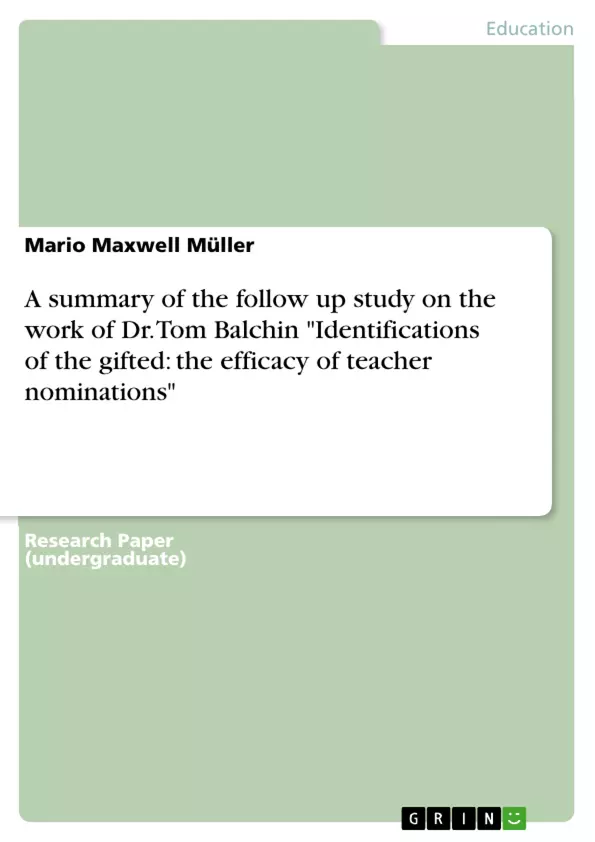This research project will be a follow up study of the work of Dr Tom Balchin’s from the University of Brunel and his research "Identifications of the gifted: the efficacy of teacher nominations". The focus of this research particularly was to concentrate on the twelve schools in the borough council of Haringey, North London in the United Kingdom. The aim of this study was to evaluate and discuss teachers’ perceptions with a level of consistency in which ways students are identified as G & T with several factors influencing their judgements and proposing what should actually be in place in order to assist schools to make provision and enhance support for students who are identified as G & T. This is a qualitative study, designed to reveal the perspective and opinions of teachers and Co-ordinators related to G & T, and to expose significant areas for further research.
Inhaltsverzeichnis (Table of Contents)
- Abstract
- Introduction
- Background
- Aim
- Research methods
- Findings
- Respondents Opinions
Zielsetzung und Themenschwerpunkte (Objectives and Key Themes)
This research project aims to understand the current education system in the UK, specifically its provisions for gifted and talented (G&T) students in the area of Haringey. The study evaluates teachers' perceptions on the identification process for G&T students, exploring factors influencing their judgments and proposing ways to enhance support for these students.
- Teacher perceptions of G&T identification
- The efficacy of teacher nominations in identifying G&T students
- The influence of cultural background on G&T identification
- The role of music education in G&T programs
- The challenges and opportunities of supporting G&T students in the UK educational system
Zusammenfassung der Kapitel (Chapter Summaries)
The research begins with an overview of the current educational system in the UK, specifically focusing on the provisions for G&T students. It examines the existing policies and procedures for identifying and supporting G&T students, highlighting concerns about the effectiveness of these methods. The author then delves into the specific focus of the study, which is to evaluate teacher perceptions on the identification process for G&T students within the borough of Haringey. The study explores the factors influencing teachers' judgments and proposes ways to enhance support for G&T students. The research methods used are discussed, and the findings are presented in detail. The author examines data collected from twelve schools in Haringey, focusing on the effectiveness of various methods for identifying G&T students. The study analyzes teachers' opinions on the most effective and ineffective sources of information for identifying G&T students, providing insights into the challenges and opportunities faced by teachers in this area. The findings shed light on the current practices and challenges surrounding the identification and support of G&T students in the UK educational system.
Schlüsselwörter (Keywords)
This research project explores themes of gifted and talented (G&T) identification, teacher perceptions, cultural background, music education, and the UK educational system. The study examines the effectiveness of teacher nominations and other methods for identifying G&T students, highlighting the challenges and opportunities of supporting these students. Key terms include: gifted, talented, education, identification, teacher nomination, cultural diversity, music, policy, UK, and Haringey.
- Citation du texte
- Masters in Music Education with Distinction Mario Maxwell Müller (Auteur), 2011, A summary of the follow up study on the work of Dr. Tom Balchin "Identifications of the gifted: the efficacy of teacher nominations", Munich, GRIN Verlag, https://www.grin.com/document/273694



